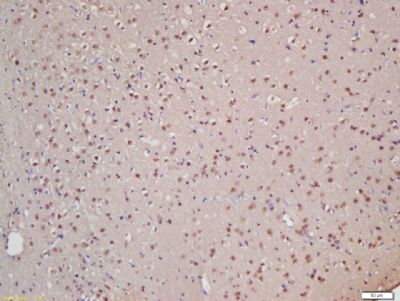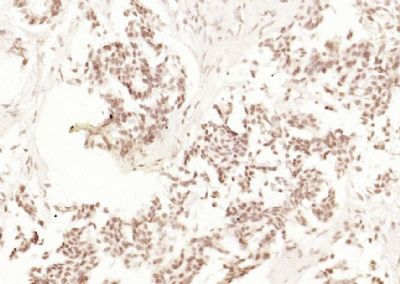XPB Polyclonal Antibody
Purified Rabbit Polyclonal Antibody (Pab)
- SPECIFICATION
- CITATIONS
- PROTOCOLS
- BACKGROUND

Application
| IHC-P, IHC-F, IF, E |
|---|---|
| Primary Accession | P19447 |
| Reactivity | Rat, Pig, Dog, Bovine |
| Host | Rabbit |
| Clonality | Polyclonal |
| Calculated MW | 89 KDa |
| Physical State | Liquid |
| Immunogen | KLH conjugated synthetic peptide derived from human XPB/ERCC3 |
| Epitope Specificity | 601-700/782 |
| Isotype | IgG |
| Purity | affinity purified by Protein A |
| Buffer | 0.01M TBS (pH7.4) with 1% BSA, 0.02% Proclin300 and 50% Glycerol. |
| SIMILARITY | Belongs to the helicase family. RAD25/XPB subfamily. Contains 1 helicase ATP-binding domain. Contains 1 helicase C-terminal domain. |
| DISEASE | Defects in ERCC3 are the cause of xeroderma pigmentosum complementation group B (XP-B) [MIM:610651]; also known as xeroderma pigmentosum II (XP2) or XP group B (XPB) or xeroderma pigmentosum group B combined with Cockayne syndrome (XP-B/CS). Xeroderma pigmentosum is an autosomal recessive pigmentary skin disorder characterized by solar hypersensitivity of the skin, high predisposition for developing cancers on areas exposed to sunlight and, in some cases, neurological abnormalities. Some XP-B patients present features of Cockayne syndrome, including dwarfism, sensorineural deafness, microcephaly, mental retardation, pigmentary retinopathy, ataxia, decreased nerve conduction velocities. Defects in ERCC3 are a cause of trichothiodystrophy photosensitive (TTDP) [MIM:601675]. TTDP is an autosomal recessive disease characterized by sulfur-deficient brittle hair and nails, ichthyosis, mental retardation, impaired sexual development, abnormal facies and cutaneous photosensitivity correlated with a nucleotide excision repair (NER) defect. Neonates with trichothiodystrophy and ichthyosis are usually born with a collodion membrane. The severity of the ichthyosis after the membrane is shed is variable, ranging from a mild to severe lamellar ichthyotic phenotype. There are no reports of skin cancer associated with TTDP. |
| Important Note | This product as supplied is intended for research use only, not for use in human, therapeutic or diagnostic applications. |
| Background Descriptions | Initiation of transcription from protein-coding genes in eukaryotes is a complex process that requires RNA polymerase II, as well as families of basal transcription factors. Binding of the factor TFIID (TBP) to the TATA box is believed to be the first step in the formation of a multiprotein complex containing several additional factors, including TFIIA, TFIIB, TFIIE, TFIIF and TFIIH. TFIIH (or BTF2) is a multisubunit transcription/DNA repair factor that possesses several enzymatic activities. The core of TFIIH is composed of 5 subunits, designated p89 (XPB or ERCC3), p62, p52, p44 and p34. Additional subunits of the TFIIH complex are p80 (XPD or ERCC2) and the ternary kinase complex composed of Cdk7, cyclin H and MAT1. Both p89 and p80 have ATP-dependent helicase activity. The p62, p52 and p44 subunits have been shown to be involved in nucleotide excision repair. |
| Gene ID | 2071 |
|---|---|
| Other Names | General transcription and DNA repair factor IIH helicase subunit XPB, TFIIH subunit XPB, 3.6.4.12, Basic transcription factor 2 89 kDa subunit, BTF2 p89, DNA excision repair protein ERCC-3, DNA repair protein complementing XP-B cells, TFIIH basal transcription factor complex 89 kDa subunit, TFIIH 89 kDa subunit, TFIIH p89, Xeroderma pigmentosum group B-complementing protein, ERCC3, XPB, XPBC |
| Dilution | IHC-P=1:100-500,IHC-F=1:100-500,IF=1:100-500,ELISA=1:5000-10000 |
| Storage | Store at -20 ℃ for one year. Avoid repeated freeze/thaw cycles. When reconstituted in sterile pH 7.4 0.01M PBS or diluent of antibody the antibody is stable for at least two weeks at 2-4 ℃. |
| Name | ERCC3 {ECO:0000303|PubMed:2111438} |
|---|---|
| Function | ATP-dependent 3'-5' DNA helicase/translocase (PubMed:17466626, PubMed:27193682, PubMed:33902107, PubMed:8465201, PubMed:8663148). Binds dsDNA rather than ssDNA, unzipping it in a translocase rather than classical helicase activity (PubMed:27193682, PubMed:33902107). Component of the general transcription and DNA repair factor IIH (TFIIH) core complex (PubMed:10024882, PubMed:17466626, PubMed:8157004, PubMed:8465201). When complexed to CDK-activating kinase (CAK), involved in RNA transcription by RNA polymerase II. The ATPase activity of XPB/ERCC3, but not its helicase activity, is required for DNA opening; it may wrap around the damaged DNA wedging it open, causing localized melting that allows XPD/ERCC2 helicase to anchor (PubMed:10024882, PubMed:17466626). In transcription, TFIIH has an essential role in transcription initiation (PubMed:30894545, PubMed:8157004). When the pre-initiation complex (PIC) has been established, TFIIH is required for promoter opening and promoter escape (PubMed:8157004). The ATP-dependent helicase activity of XPB/ERCC3 is required for promoter opening and promoter escape (PubMed:10024882). In transcription pre-initiation complexes induces and propagates a DNA twist to open DNA (PubMed:27193682, PubMed:33902107). Also involved in transcription-coupled nucleotide excision repair (NER) of damaged DNA (PubMed:17466626, PubMed:2111438, PubMed:8157004). In NER, TFIIH acts by opening DNA around the lesion to allow the excision of the damaged oligonucleotide and its replacement by a new DNA fragment. The structure of the TFIIH transcription complex differs from the NER-TFIIH complex; large movements by XPD/ERCC2 and XPB/ERCC3 are stabilized by XPA (PubMed:31253769, PubMed:33902107). XPA retains XPB/ERCC3 at the 5' end of a DNA bubble (mimicking DNA damage) (PubMed:31253769). |
| Cellular Location | Nucleus. |

Thousands of laboratories across the world have published research that depended on the performance of antibodies from Abcepta to advance their research. Check out links to articles that cite our products in major peer-reviewed journals, organized by research category.
info@abcepta.com, and receive a free "I Love Antibodies" mug.
Provided below are standard protocols that you may find useful for product applications.
If you have used an Abcepta product and would like to share how it has performed, please click on the "Submit Review" button and provide the requested information. Our staff will examine and post your review and contact you if needed.
If you have any additional inquiries please email technical services at tech@abcepta.com.













 Foundational characteristics of cancer include proliferation, angiogenesis, migration, evasion of apoptosis, and cellular immortality. Find key markers for these cellular processes and antibodies to detect them.
Foundational characteristics of cancer include proliferation, angiogenesis, migration, evasion of apoptosis, and cellular immortality. Find key markers for these cellular processes and antibodies to detect them. The SUMOplot™ Analysis Program predicts and scores sumoylation sites in your protein. SUMOylation is a post-translational modification involved in various cellular processes, such as nuclear-cytosolic transport, transcriptional regulation, apoptosis, protein stability, response to stress, and progression through the cell cycle.
The SUMOplot™ Analysis Program predicts and scores sumoylation sites in your protein. SUMOylation is a post-translational modification involved in various cellular processes, such as nuclear-cytosolic transport, transcriptional regulation, apoptosis, protein stability, response to stress, and progression through the cell cycle. The Autophagy Receptor Motif Plotter predicts and scores autophagy receptor binding sites in your protein. Identifying proteins connected to this pathway is critical to understanding the role of autophagy in physiological as well as pathological processes such as development, differentiation, neurodegenerative diseases, stress, infection, and cancer.
The Autophagy Receptor Motif Plotter predicts and scores autophagy receptor binding sites in your protein. Identifying proteins connected to this pathway is critical to understanding the role of autophagy in physiological as well as pathological processes such as development, differentiation, neurodegenerative diseases, stress, infection, and cancer.



